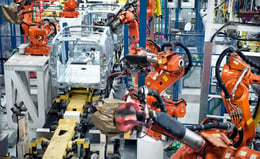How Industry 4.0 Will Impact Your APS in 2021
Brian Hoey - August 15, 2019

 Let’s says you’re playing chess. Traditionally, a chess player looks at the whole board and comes up with an overarching strategy, which she can then adjust as needed when new conditions (i.e. her opponent's strategies and maneuvers) emerge. For this game, however, you decide to do something different: you have a series of different plans, one for the pawns, one for the bishops, one for the queen, etc. with no obvious connections or interplay between them. As situations arise in which multi-step, cross-functional movements would be helpful, you stay in your lane and stick to the separate plans for each function. At the end of the game, your rooks have performed admirably, and everything went according to plan for your pawns, but you still found yourself in checkmate.
Let’s says you’re playing chess. Traditionally, a chess player looks at the whole board and comes up with an overarching strategy, which she can then adjust as needed when new conditions (i.e. her opponent's strategies and maneuvers) emerge. For this game, however, you decide to do something different: you have a series of different plans, one for the pawns, one for the bishops, one for the queen, etc. with no obvious connections or interplay between them. As situations arise in which multi-step, cross-functional movements would be helpful, you stay in your lane and stick to the separate plans for each function. At the end of the game, your rooks have performed admirably, and everything went according to plan for your pawns, but you still found yourself in checkmate.
This hypothetical might strike you as a little ridiculous, but if we carry the allegory into a manufacturing context, we’ll find that this is the way that many businesses managed resources for many years in the pre-digital era. Planning and scheduling were done by hand, often in discrete planning silos, meaning that teams often worked at cross purposes and plans were difficult to amend on the fly. The birth of advanced planning and scheduling (APS) software (combined with the requisite increase in cross-functional visibility) made a huge difference in this sphere, but it has historically found businesses continuing to battle silos. This is where Industry 4.0 comes in.
What Is Advanced Planning and Scheduling?
Let’s back up a step. In the modern, digital era, many manufacturers consider APS to be a practical necessity. Why? Because it helps to answer the critical question that has been asked by every manufacturer since the dawn of commerce—what should we produce, when? By offering an overview of available resources and existing or pending customer orders, APS systems help to create production environments in which demand and capacity can be effectively matched to one another, reducing the likelihood of disruptions and lowering costs in the form of reduced waste and buffer stock. By taking the planning process out of the spreadsheets and notebooks of human planners in this way, manufacturing outfits are able to drive ever closer to optimal production scheduling.
Even the most sophisticated APS system, however, doesn’t automatically eliminate planning silos and stave off all supply chain disruptions. Because the production schedules being generated depend on the accessibility of large quantities of production and supply data (which, on some level, necessitates manual integration), companies run a real risk of gaps emerging in their information, which could lead to sub-optimal plans. By the same token, even a well-integrated APS solution doesn’t necessarily have the tools to anticipate future demand effectively, which means that planners are often still making decisions based on past events, making proactive action difficult or impossible. To fill in these gaps, manufacturers need new paradigms in data collection and forecasting.
Industry 4.0
Because Industry 4.0 is based largely on automating the collection of data (especially from things like internet of things [IoT] devices and RFID sensors), it’s easy to see how it might help to fill in the gaps that could arise in your production planning. If, for instance, you were trying to plan out order fulfillment for a given week in your smart factory, instead of relying on inventory information that might be outdated when planning your resource allocation, you could rely on real-time data being transmitted directly from your parts warehouse via IoT sensors. In this way, you can be certain of using the most up-to-date information. From there, you might use sensors on your actual production lines to monitor your workflows in real time, thereby gaining a more complete picture of how and where you might slot in a last minute order, for instance.
Of course, Industry 4.0 is also an important driver of the adoption of advanced analytics and AI workflows—i.e. exactly the kinds of things that could help improve demand forecasts and power process improvements for manufacturers across the board. Since your smart factory is ostensibly gathering large quantities of data anyway, this is an ideal way to put that data to use and derive real added value from it. Thus, you might find that, using sensor data accumulated over the course of numerous production runs, your advanced prescriptive analytics processes are able to pinpoint areas where your factory floor arrangements could be tweaked to reduce breakdowns. Conversely, years worth of customer orders might be fed into an advanced predictive algorithm in order to better predict future customer behavior. In this way, you can unshackle yourself from the logic of the past and create a truly proactive value chain.
Reimagining the Digital Supply Chain
Okay, so far the answer to the title question of this piece has been a little oblique. Let’s come right out and say it: Industry 4.0 has the power to make your APS more effective by providing greater data visibility and improved analytics integration. This can have repercussions not just for your demand and capacity planning, but for your entire supply chain. After all, the logical next step beyond integrating IoT devices and analytics processes into your production flows is to extend them beyond the factory floor and into your logistics chain.
In this way, Industry 4.0 has the power not just to improve your APS flows, but also to create better alignment between those processes and your larger operational challenges and goals. If we think back to our opening chess analogy, this goes beyond simply looking at the whole board and implementing an adaptable strategy—it’s more like a chessboard on which each individual piece can report back to you on matters of tactics and conditions in the field. Rather than a completely top down approach, you have a structure where individual functions are able to course-correct on their own and information flows freely throughout the entire organizational structure. Thus, APS becomes an important node in a data-driven decision-making structure, interacting synergistically with other nodes like enterprise resource planning and supply chain planning.
LATEST POSTS
- Understand Why Production Planning Needs Specialized Solutions
- Understand Circular Economy in The Manufacturing Industry
- How Can Industry 4.0 IT Integration Be Achieved Smoothly?
- The Significance of Order Sequencing in Discrete Manufacturing
- How to improve your Supply Chain Management: The Power of Control Towers



